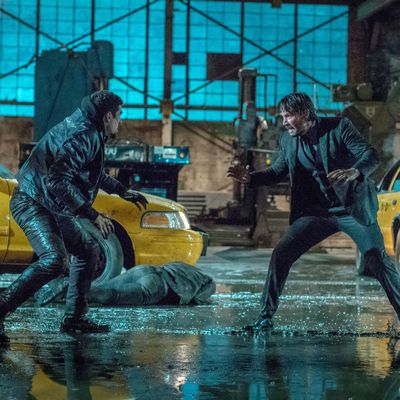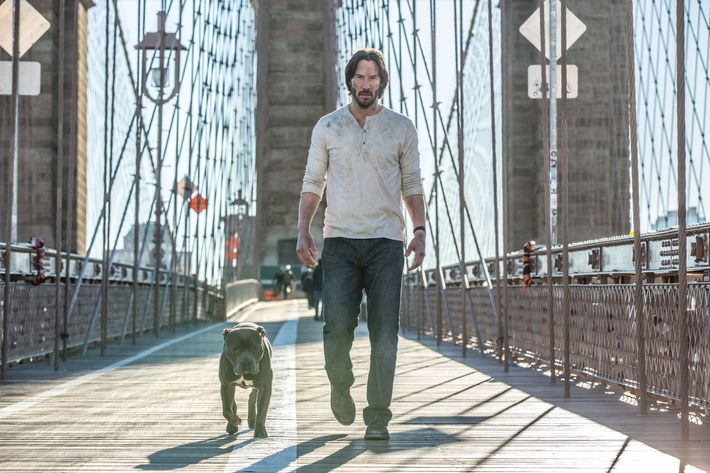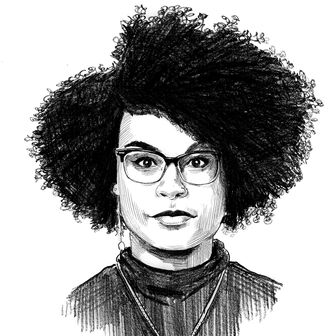
Hollywood action stars are often tied to a sense of time and place. From early figures in this canon, like the dashing Errol Flynn in 1938’s The Adventures of Robin Hood to the oiled-up stoicism of Arnold Schwarzenegger in the 1980s and 1990s, they’re intrinsically linked to the eras they’ve born into and the Western tradition they work within. The same can’t be said of Keanu Reeves.
Reeves was born in Beirut, moved around the world frequently in his youth, and was raised in Toronto. His background (he has a mix of white, Native Hawaiian, and Chinese ancestry), along with his upbringing, mirrors how difficult it is to pinpoint his place in action-movie history. That he’s endured over the years in ways many of his 1990s contemporaries haven’t is a testament to his unique skills as an action star. From the unabashedly ridiculous Speed to the laconic cynicism of Constantine, Reeves’s work is most informed by two very different influences: Hong Kong action flicks and classic Hollywood. His return to the action genre with John Wick: Chapter Two, now in theaters, is perfect timing — the genre needs him now more than ever.
The best way to understand how Hong Kong action films influence Reeves is to look at his directorial debut, Man of Tai Chi. The film is anchored by a performance by Tiger Chen, a martial artist and fight choreographer who met Reeves in the late 1990s training him for The Matrix. As critic Priscilla Page notes in her appraisal of the film, “There are no stunt doubles. Like John Wick, the action is fluid, a pleasure to watch — no frenetic, Bourne-ripped shaky cam, most of the fighting was filmed with Steadicam.” It has a great understanding and reverence for the visceral kung fu films Reeves watched in his youth, particularly Enter the Dragon, whose ethos snakes through Reeves’s career as an action star particularly post-Matrix. (Reeves has also pointed to Fist of Legend, Twin Warriors, 5 Fingers of Death, and The Matrix, a film that synthesizes a variety of different inspiration, as influences on Man of Tai Chi.) Take this scene from the 1973 film:
Once the fight starts between Lee (Bruce Lee) and O’Hara (Robert Wall), there is little dialogue. The way the actors move and fight informs the animosity between them. It’s entirely different from the way American action stars, who make time for quips between blows, interact in such moments. The best sequences in Enter the Dragon are when the film operates in wide shots, finding a kinetic energy as Lee dances around his opponent. Man of Tai Chi and John Wick: Chapter Two adopt a similar philosophy, which speaks to both the intelligence of their directors and the skill of their stars. For fight scenes in films like these, the men at the center need to be well-trained, charismatic, and understand the relationship between their bodies and the camera. It’s something that’s largely missing in the performances of modern action stars, who are most regularly seen in superhero epics. The problem with how superhero films are crafted and acted is they often rely on the mythology of the source material without giving audiences who know nothing about these characters enough of a reason to care about them. They’re poorly shot and overedited in ways that make what should feel like grand action scenes forgettable. (DC’s recent critical failure Suicide Squad is the most damning example of this trend.) The men at the center, like Chris Hemsworth and Chris Pratt, often lack an understanding and reverence for the genre they are moving within, which shows in their surface-level performances. They’re charming, sometimes even charismatic, but it’s hard to say they’re memorable in the way Bruce Lee is in Enter the Dragon or Reeves himself.
John Wick: Chapter Two’s director Chad Stahelski spoke to Empire about the film’s influences: “You go watch any of the great Hong Kong guys. [You’re watching] wider shots; you’re watching an extremely talented individual. If you’re using fast editing to hide things, I call bullshit,” he said. “That’s cheating. Luckily, we have a cast member that can do it. Reeves been doing martial arts for 25 years. He’s been trained by us, he’s been trained by Yuen Woo-ping. He’s been trained by Chen Yen.” Reeves is not an actual martial artist like the men who center many of the works he names as inspiration. But he has a work ethic and respect for the form that John Wick: Chapter Two takes advantage of. His dedication and love of the genre puts him more in the lineage of Asian and Asian-American martial arts stars like Bruce Lee, Jet Li, and Jackie Chan than it does Western action stars. An extravagant mirror scene climax in John Wick: Chapter Two, for example, in which Wick and his opponents crash through glass, is a direct reference to Enter the Dragon. But this isn’t the only classic Hong Kong film the sequel draws on. The gun-fu in John Wick: Chapter Two, and Reeves’s handling of it, owes a debt to films like 1992’s Hard Boiled starring Chow Yun-fat. Gun-fu is a style in which the gunplay in a fight scene is choreographed to make it feel balletic and graceful. Director John Woo can be credited with popularizing this style in films like 1986’s A Better Tomorrow, which also starred Yun-fat:
Watching John Wick: Chapter Two next to films like this, we can see the influence — wider shots, longer takes, unfussy editing. This gives the action room to breathe and amps up the tension. Violence takes on a soulful quality. But for this to work, you need an actor like Reeves who has the presence to make such scenes be more than just an exercise in physical prowess. Watching Reeves, I am reminded of what director John Woo said about Chow Yun-fat in an interview: “I wanted to create a new kind of hero, a hero who can stand for me, can speak for me, and also can speak for the audience, someone close to the audience, not like a superhero.” That Woo later compared Yun-fat to classic stars like Cary Grant and Paul Newman isn’t a coincidence. It speaks to the way Western and Eastern films have always influenced each other, as well as the brand of stardom necessary for action films to have meaning beyond the craft that goes into them.
Reeves is particularly unique as an action star because he’s also able to use physicality to communicate story outside of action sequences in ways that Lee, Chan, and Li often weren’t. Part of the reason for this is the constraints of the Hong Kong industry itself, which had no tradition of acting schools like its British, and to a lesser extent, American peers (even Keanu, for example, has been onstage in Hamlet), as well as these films’ interest in visceral action over emotional plot dynamics. Even within John Wick: Chapter Two’s dazzling, over-the-top world, Reeves keeps his character grounded by communicating his exhaustion, pain, and grief simply in the way he walks through the frame, never letting you forget how bruised John Wick is physically and emotionally.

At the very beginning of John Wick: Chapter Two, projected onto a New York building is a clip of a Buster Keaton film. It appears so briefly you could easily miss it. But it nods to the other tradition Reeves is working within: silent film and classic Hollywood stardom. This is evident in Reeves’s relationship with the camera, which embraces his object-of-desire status without making it seem self-involved or an outright punch line. While in many action films the weaponry takes on a near fetishistic glow, Reeves becomes the camera’s main interest, as lovingly shot as the glamorous starlets of classic Hollywood.
The language of the body is one that American audiences, no matter how far removed we are from this country’s Puritan beginnings, may not know how to speak. It’s a language that was far more common in classic cinema because the industry saw beauty not only as a selling point, but a thematic tool worth exploring. The Hong Kong action stars that Reeves drew from for Man of Tai Chi, the John Wick films, and The Matrix trilogy understood how to convey the bliss and beauty of a fight scene, making violence into a dance. The greatest classic Hollywood actors, on the other hand, understood how to make every moment a dance within itself. They used their bodies to convey character and presence in a way that enriched the film. As actor Mitchell Fain said in a conversation about Joan Crawford, “The stars were the architecture [and] their shape meant something to a camera.” For all of cinema’s growth over the last several decades, modern stars lack the same sort of intimacy with the camera you saw in classic Hollywood that can elevate even the most slapdash film into something watchable, even entrancing. These were people who knew their angles, how the light hit them, and used stillness as a profound storytelling tool. It’s these stars who can rise above being engaging and charismatic to become an elemental force. Reeves is one of them.
What makes Reeves different from other action stars is this vulnerable, open relationship with the camera — it adds a throughline of loneliness that shapes all his greatest action-movie characters, from naïve hotshots like Johnny Utah to exuberant, “chosen ones” like Neo to weathered professionals like John Wick. The best way to understand how Reeves expertly deploys this strategy is to compare him to his action contemporaries from the 1990s and today. Turn the films on mute and study how these actors move. This isn’t meant to insult Reeves’s line readings, which many still can’t seem to separate from his Bill and Ted’s Excellent Adventure beginnings. Half of what makes John Wick: Chapter Two work as a sequel is its surprising humor, anchored by Reeves’s deadpan delivery and notes of exhaustion. But watching him on mute, it’s clear how much he’s able to communicate without saying a word. A downcast glare, a clenched jaw, the sudden sloping of his shoulders in the rare moments he relaxes in the sequel say more than any of the dialogue. Compare this to his fellow 1990s action heroes, who ranged from the overwrought machismo of Arnold Schwarzenegger (Terminator 2) to brutal everymen with a joke for every situation they find themselves in like Bruce Willis (the Die Hard franchise) to the more purely comedic like Will Smith (Bad Boys, Independence Day). Nineties action stars represent the physical peak of the male body taken to, at times, cartoonish limits. They’re strong jawed and overmuscled. Their very bodies harden them to the world and shield them from any hint of emotional vulnerability you might glean from watching them move across the screen. Reeves isn’t masculine so much as he is beautiful. His work throughout the years in films like Speed, Point Break, and even the much maligned Johnny Mnemonic, have a sort of sweetness, approachability, and vulnerability that stands out from the work of his peers.
Action stars, past and present, speak profoundly to the American id (or at least Hollywood’s conception of it). In many ways, the shifts in how masculinity is presented in action films also speaks to the kind of men this country seeks to uphold. By and large, action heroes espouse the ethos of traditional masculinity, arguing for a fairy tale time in American history when “men were men.” The action stars we see today typically mix swagger, quips, and time-honored sexism along with their heroics (chart the arc of any character Chris Pratt has played recently). There are a few examples to the contrary like Chris Evans’s kind Captain America, who is nearly moralistic to a fault. But his vulnerability lacks the nuance and intimacy that Reeves excels at. The closest parallel to Reeves is perhaps Tom Cruise, considering how his career as an action star has stretched from the late 1980s and shows no signs of slowing down. But unlike Reeves, he’s never allowed his characters to be vulnerable in quite the same way. For Cruise, his charm is a weapon to deploy, not a human quality that entices.
By and large, Hollywood action heroes revere a troubling brand of American masculinity that leaves no room for displays of authentic emotion. Throughout Reeves’s career, he has shied away from this. His characters are often led into new worlds by women of far greater skill and experience (Point Break and The Matrix being great examples). There is a sincerity he brings to his characters that make them human, even when their prowess makes them seem nearly supernatural. From his everyman hotshot in Speed to his isolated occult detective in Constantine to his transcendent work in John Wick: Chapter Two, Reeves is at once vulnerable, lonely, yearning, and endlessly watchable. He’s an actor who bridges divides — between masculine and feminine, visceral action and human emotion, classic Hollywood grace and Hong Kong action-film brutality — in a way Hollywood would do well to learn from.





